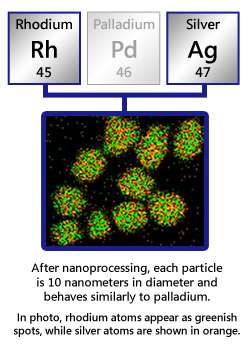Pseudo palladium

Pseudo palladium (RhAg) is a binary alloy consisting of equal parts of Rhodium (atomic number 45) and Silver (atomic number 47) created using nanotechnology to create a far more homogenous mixture than might be possible using more conventional methods. This alloy exhibits properties of the intervening element Palladium (atomic number 46).
History
The production of this alloy was first reported by Kyoto University Professor Hiroshi Kitagawa and his research team, October 27, 2010.[1] To make the new alloy, the Kyoto team used nanotechnology to "nebulise" the rhodium and silver and gradually mixed them with heated alcohol, with the two metals mixed stably at the atomic level. The same team also produced alternatives to other kinds of rare metals.[2]
Characteristics
The new alloy has similar properties to palladium, which is used as a catalyzer to cleanse exhaust gas and absorbs large quantities of hydrogen.
Rhodium, palladium and silver have 45, 46 and 47 electrons, respectively, numbers that determine their chemical characterizations.
"The orbits of the electrons in the rhodium and silver atoms probably got jumbled up and formed the same orbits as those of palladium," Kitagawa said.[3]
Applications
The alloy has similar properties to palladium, which is used in cars' emission-reducing catalytic converters as well as in computers, mobile phones, flatscreen TVs and dentistry instruments.
Japan's industry ministry has listed 31 rare metals, including palladium and lithium, which are used in industrial products, such as electronic devices and batteries. Of these, 17 elements are called rare earth minerals.[4]
China produces 97% of the global supply of rare earths, which are used in computers, wind turbines and electric cars.
But China has announced that it will be cutting the export of its rare earths by 35%, which has forced the world to scramble for alternative sources of rare earths.
The Japanese response has not only been to attempt to create the metals they need artificially, but also to find alternative global sources.
Hydrogen storage is cited as one potential use, however, according to researchers, the pseudo palladium alloy has only one half of palladium's hydrogen storage capacity.[5]
See also
References
- ↑ "Hydrogen-Storage Properties of Solid-Solution Alloys of Immiscible Neighboring Elements with Pd". Retrieved 2010-01-08.
- ↑ "Japan nano-tech team creates palladium-like alloy". Retrieved 2010-01-08.
- ↑ "Japan creates 1st artificial rare metal". Retrieved 2010-01-08.
- ↑ "Japan nano-tech team creates palladium-like alloy". Retrieved 2010-01-08.
- ↑ "Scepticism greets Japanese synthetic palladium claim". Retrieved 2010-01-08.